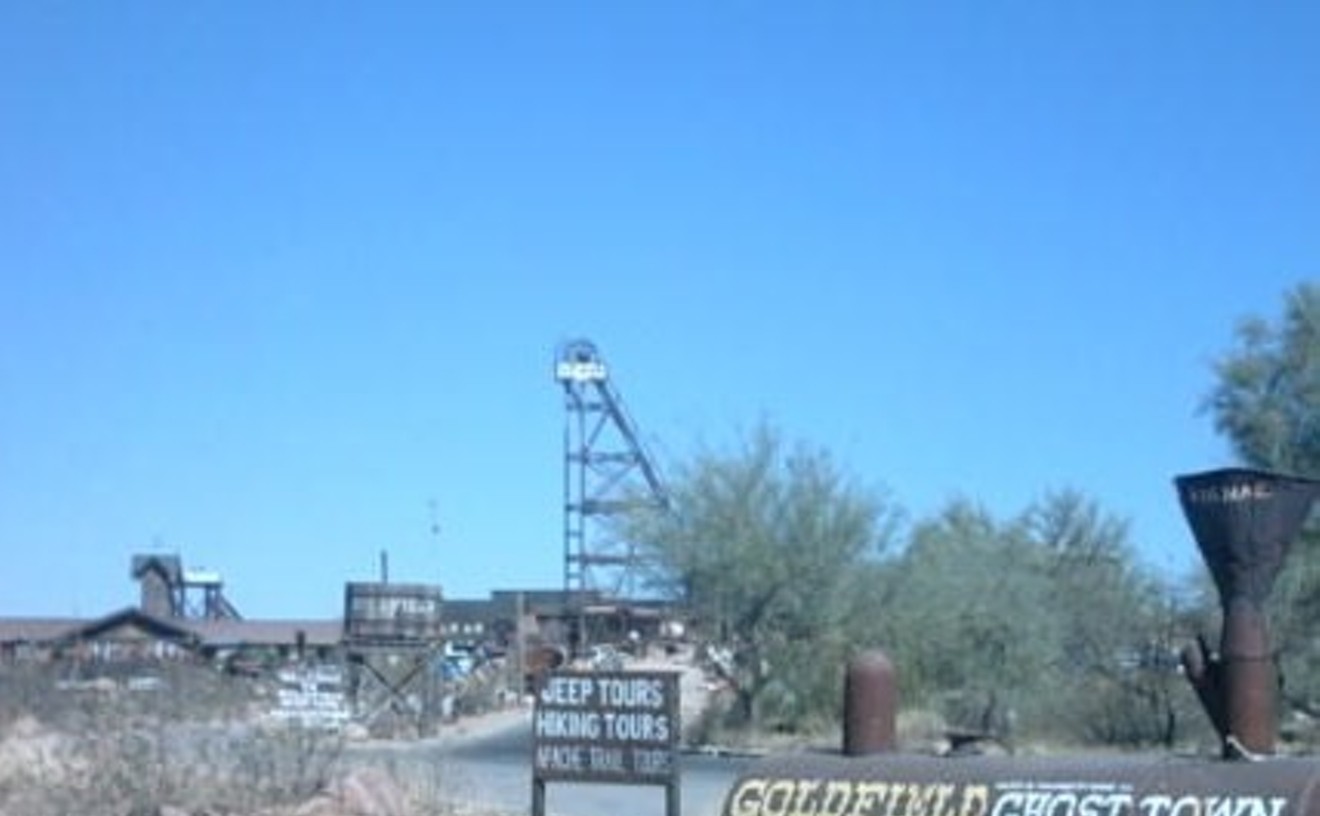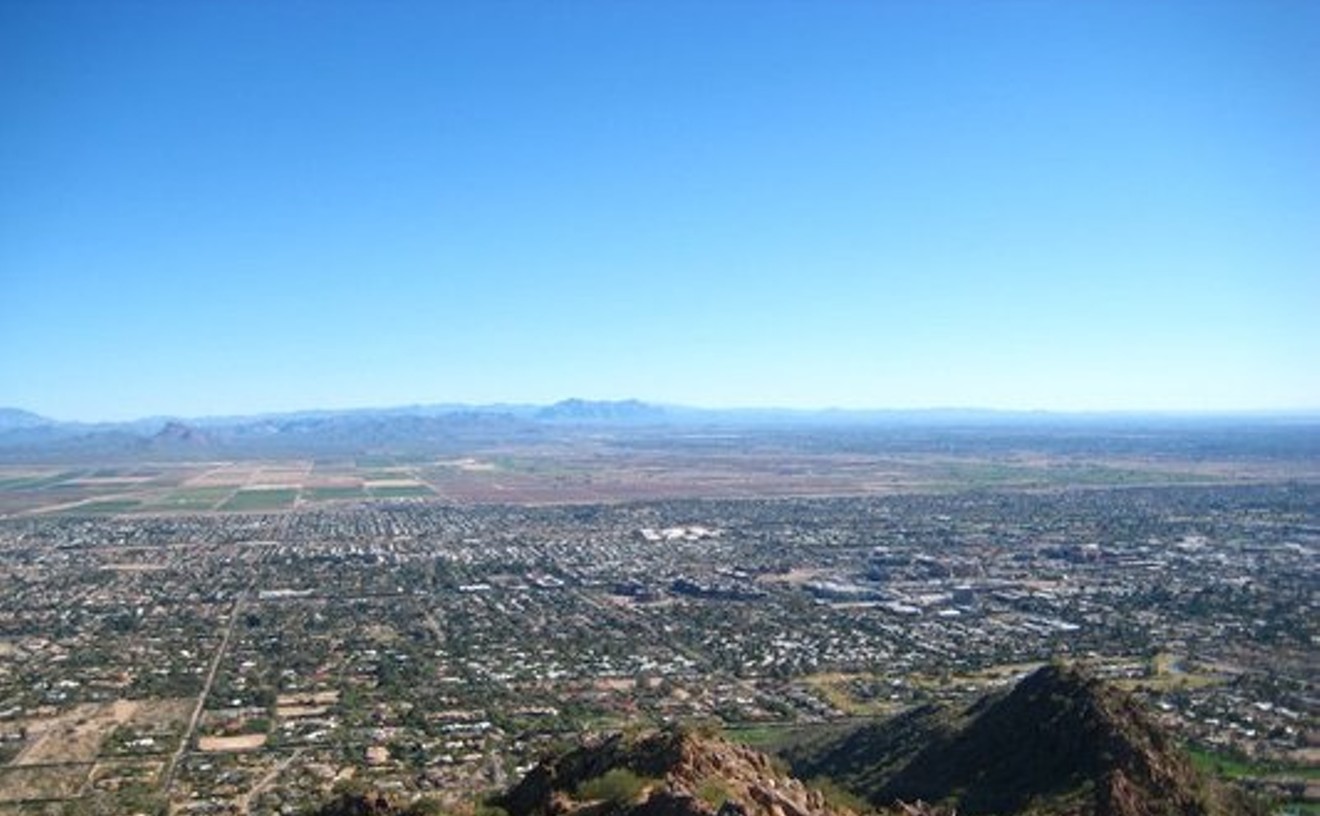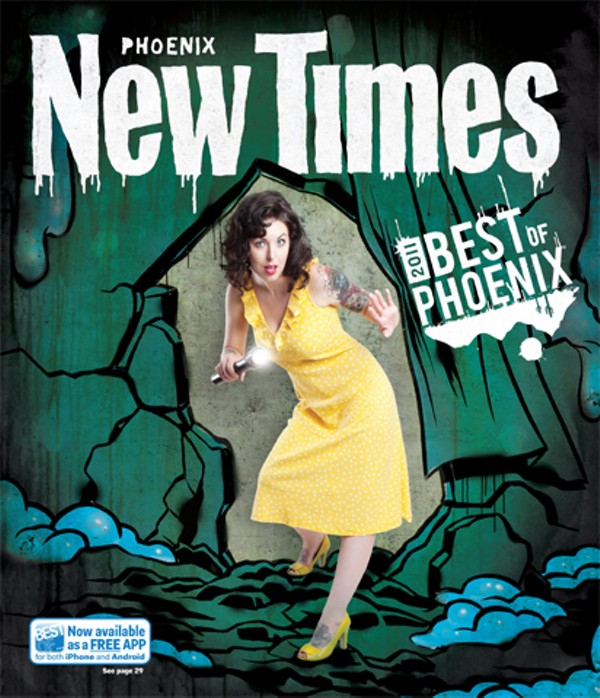Best Mine Tour
Goldfield

We'll admit — Goldfield isn't for everyone. But if you are the type of person who loves a little kitsch, then you might find a place in your heart for the campy town of Goldfield. According to our tour guide, the tourist trap was once a booming mining town — until one of the most productive mines in the West was flooded. (Unless you had some high-tech scuba equipment, there was no way you were pulling gold outta there.) Learn all about the workings of the mines and the demise of the town after you travel, via a bumpy elevator ride, into the cool mine shaft below. Once underground, your gritty prospector will take you on a journey through the cavernous tunnel, where you will learn all about life in a mine. Be sure to watch the little kids' faces as the "widowmaker" and the "honeybucket" are explained. Those priceless looks alone are worth every penny of the $5 tour. Don't forget to tip the prospector — without him you would just be wandering around a boring hole in ground.
- 4650 N. Mammoth Mine Rd., Apache Junction, 85219 Map
- 480-983-0333
- www.goldfieldghosttown.com
Best Ruins
Willow Spring Trail
There's something exciting about coming across the remnants of a human settlement while on a long hike through an otherwise barren landscape. Who lived here? Why this spot? Where'd they go? How the hell did they get up all that stuff up here? In the case of the abandoned ranch just off the Willow Springs Trail through the White Tank Mountains on the Valley's western edge, at least one of these questions is easy to answer. The men who settled here — from the looks of it, cattle ranchers — picked the shadiest spot around, near a deep spring. The White Tanks are named for the granite pools that collect water on their face, reserves that have drawn human inhabitants for thousands of years, as demonstrated by the petroglyphs that line these peaks like graffiti in a rail yard, left by the seven villages of Hohokam who once settled here. Yet this little riparian spot is still uniquely captivating. Barbed wire, several long rock fences, a rusty water tank, and the ruins of what looks like a house give a glimpse into the hardscrabble lives of the people who settled this town before the advent of air conditioning and 10-lane freeways. Explore for a bit before heading back down into society — or moving on to The Black Rock Trail, which takes you to less-preserved Indian ruins.
- 13025 N. White Tank Mountain Rd., Waddell, 85355 Map
- 623-935-2505
- www.maricopa.gov/parks/white%5Ftank/
Best Cave
Phoenix Bat Cave
Beginning each spring and continuing until the temperatures really start to climb in the summer, thousands of bats migrate to the so-called "Phoenix Bat Cave" near the Arizona Biltmore. The "cave" is actually a Maricopa County Flood Control ditch, but it has the proper temperatures and protection for these tiny flying creatures. During bat season, visitors to the cave (which is marked by a plaque from the Arizona Department of Game & Fish) can see dozens of bats flying out at dusk, hunting insects. There are two types of bats who make their home here: the western pipistrelle, which is the smaller of the two groups and the first to fly out of the cave in the evenings in fluttery flight patterns, and the Mexican free-tailed bat, which is a female colony that comes to the cave to birth and raise their young (the highest number are believed to be in the cave in July and August). Accessing the cave requires parking near 40th Street and Camelback, then walking along the north side of the Arizona Canal for about half a mile. The entrance to the cave is behind Phoenix Country Day School, north of the canal.
Best Hiking Trail
Camelback Mountain's Cholla Trail

It's easy to see why Camelback Mountain has some of the most popular trails in the Valley, as the top of the red sandstone "hump" provides an unparalleled view of Phoenix. Most people are familiar with the Echo Canyon trail, but we like the slightly easier Cholla Trail. We say slightly easier because while you'll still end up sweating like a whore in church, it's a bit less steep. The last eighth of a mile before the summit does require a bit of rock scrambling — so leave Rover at home if you plan on reaching the top. And whatever you do, bring plenty of water and know your limits. Hiking should be fun, not harrowing. Nobody wants to be the dingbat who gets airlifted off Camelback.
- 6200 E. Cholla Way, Scottsdale, 85254 Map
- www.phoenix.gov/recreation/rec/parks/preserves/locations/camelback/cholla/index.html
Best Place to Find an Underground Bike Race
AZ Fixed
For most folks, an alley cat is that annoying feline that roots through your garbage and causes endless caterwauling at all hours of the night. For local cyclists or riders of fixed-gear two-wheelers, however, alley cats are under-the-radar urban bike races that are ultra-competitive and ultra-fun. Best described as a cycling scavenger hunt, alley cat races feature riders zipping around a certain area of the Valley as fast as their muscular legs can carry them in between various checkpoints. These events usually feature a theme, as well as pimp after-parties, where the winners are toasted and the losers get roasted. Due to their quasi-legal and DIY nature, alley cats are announced on the down-low. In fact, the only way you can find out about the next race is by checking out local cycling message board AZ Fixed. Populated by local cyclists and fixed-gear aficionados, the site is also a place to learn of more subdued jaunts like a weekly ride by the Tempe Bicycle Action Group or the Critical Mass excursion on the final Friday of every month. As one AZ Fixed user by the name of Zap states, the site's raison d'être is simple: "It's all about having a good ol' time on your bike."
Best Hike Through the Heart of the City
Christiansen Trail #100 to North Mountain Park

Phoenix's city park system is one of the largest and best in the world, and the Christiansen Trail gives a nice crash course on what it has to offer. This marathon 10.7-mile trail stretches the width of the Phoenix Mountains Preserve, from Tatum Boulevard on the east to Seventh Avenue on the west. You'll traverse much of the city on foot — mostly off the grid, with a few glimpses into posh neighborhoods. It's thrilling, and a little odd, to be in the middle of the sixth-largest city in the country yet totally immersed in the outdoors. Though the trail's long, there is only about 200 feet of elevation gain, so it's also pretty easy. Don't worry about playing Frogger on busy roads, either, as you'll take tunnels under State Route 51, Cave Creek Road, and Seventh Street. We recommend starting early at the tiny eastern trailhead at Tatum and Tomahawk so you begin the day looking up at Camelback before making your way west, slipping around Piestewa Peak and over toward North Mountain. The scenery gets less impressive as you head west. Arrange a ride from the other side after you've ended in a developed city park with restrooms and full cell coverage.
- 10600 N. Seventh St., Phoenix, 85020 Map
- 602-495-5540
- www.phoenix.gov/PARKS/northmnt.html
Best Thing to Do By the Light of the Silvery Moon
McDowell Mountain Ranch Longboard Rides
Imagine surfing, but picture doing it downhill on a hard, smooth surface at speeds up to 55 miles per hour. In the dark. With a bunch of other people flying down the hill around you. In a nutshell, that's downhill longboarding in the Valley, where rides and timed races take place every month during the full moon at McDowell Mountain Ranch.Longboarding was developed on the West Coast in the 1950s and requires the use of a wheeled board that is generally up to 59 inches long. The downhill aspect, in which riders fly downhill as fast as they can while trying to maintain control of the board, has a large following in Phoenix but has stayed pretty quiet while growing over the past two years. Anywhere from a dozen to 25 people participate in the full-moon rides, as well as at downhill longboarding events at South Mountain, but the events are so under wraps that they're almost impossible to catch. (In fact, they eluded the Best Of team all summer!) The full-moon rides at McDowell Mountain Ranch are organized by former NAU student Ryan Chopko, who announces monthly events only to members of a longboarding group on Facebook. He says the moonlit rides are "pretty intense.""It's dark. There's not much light, except the light from the full moon. And we move down the hill really, really fast," Chopko says. Generally, boarders meet at a location near McDowell Mountain Ranch around 9:30 p.m. Riders are shuttled to the top of a hill and dropped off. Speeds are clocked by timekeepers at the top and bottom of the hill, and if everybody's pitched in some money, winners can get prizes. (Chopko generally asks for a $5 buy-in per boarder.)You can only keep a good secret for so long. What started as an underground event is quickly moving into the mainstream. "Our full moon event is . . . becoming so well known it almost doesn't require advertisement," Chopko says. "Which is so crazy to me, because two years ago, it was something so small and private. No one knew what the heck it was."
Best Hike in Immigrant-Smuggling Territory
Table Top Mountain Wilderness
Until a couple of years ago, online trip reports about the two main trails cutting through the 34,400-acre Table Top Mountain Wilderness area detailed nothing but the pleasures of hiking in the rugged, cactus-filled terrain located 20 miles or so south of Maricopa. These days, it's more common to hear warnings about the federal preserve. "I'd be very careful," a ranger with the Bureau of Land Management's field office tells us (you can call them at the number listed above) when we inquire about a planned trip to wilderness within the now-infamous Vekol Valley, south of Interstate 8. Not only do signs warn outdoors enthusiasts that they're entering an area rife with human- and drug-smuggling activity, but earlier this year, the BLM completed work on a 1.3-mile "Normandy-style" vehicle barrier between the Table Top Wilderness and the northern edge of the Tohono O'odham reservation. Many illegal immigrants and their guides filter through the BLM land every year, often using the distinct Table Top Mountain as a navigational guide. Gun battles are not uncommon. No hikers have been messed with — yet. We're holding off on the summit trail hike until we find a small herd of fellow risk-takers willing to accompany us.
Best Place for Info on Arizona Caves and Caving
Arizona Cave Survey
There are more than 1,600 documented caves in Arizona, and much of that documentation has come from Arizona Cave Survey, a group of caving enthusiasts who've built up an impressive library and database on the subject. The library consists of books, maps, photos, and even a cave location GIS system, making it an incredible resource for cave researchers. From Lava River Cave in northern Arizona to Colossal Cave in Tucson, ACS has all the information a researcher needs. But novices beware: ACS is also concerned with the preservation of our state caves and will not give out cave locations to the general public, referring inexperienced cavers to local chapters of the National Speleological Caving Clubs for some background and education first. But seasoned cavers who contact them might get some assistance (after their references are checked), and provided they're not looking to explore a "sensitive" cave — i.e., a cave that may be hazardous or is easily damaged, for which ACS divulges no information.
Best Hike to See the Sonoran Desert
Spring Valley Trail, Hells Canyon Wilderness
Despite the hellacious name of this wilderness area just north of Lake Pleasant, the Spring Valley Trail is a kid-friendly hike, according to some Internet guides. We found it well defined and maintained, but it's not all that cushy, thanks to the climbs into and out of the many arroyos, or desert washes. From Lake Pleasant Drive or Highway 74, take Castle Hot Springs Road north a short way to the trailhead parking lot. Most people end their hike in one of the washes about 2.5 miles from the start, though would-be explorers can bushwhack down the wash or elsewhere. Even if you go in only a mile or so, you'll have a quintessential desert experience that pulls you into a pristine wonderland of healthy-looking saguaros, cholla, palo verdes, wildflowers (in February), and other desert flora. The place was a regular Serengeti on our outing: We encountered several wild burros, range cattle, and — best of all — a fully grown desert tortoise nestled in a shady cubbyhole of dried mud. We left him alone, as you should do if you find him or his siblings. No doubt, other Sonoran creatures — like rattlesnakes — can be found in this still-wild spot, so keep your finger on the shutter button. And get ready to run like hell.





